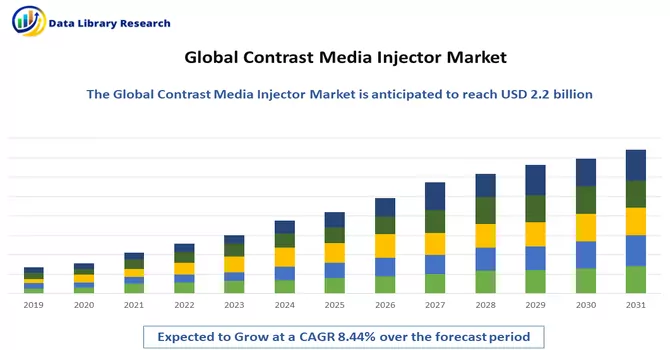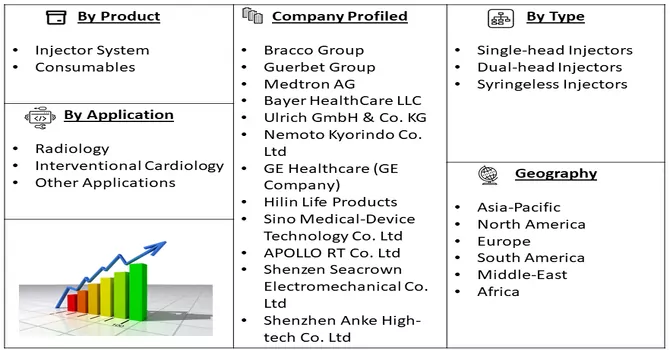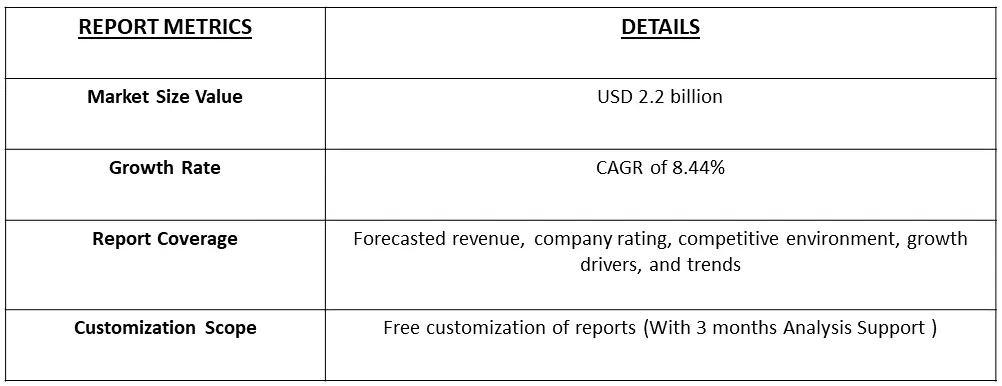The Contrast Media Injectors Market size is estimated at USD 2.2 billion in 2023 and is expected to a CAGR of 8.44% during the forecast period (2024-2031).

Get Complete Analysis Of The Report - Download Free Sample PDF
A contrast media injector, also known as a contrast injector or contrast delivery system, is a medical device used in diagnostic imaging procedures such as computed tomography (CT) scans, magnetic resonance imaging (MRI), and angiography. Its primary function is to administer contrast media, a substance that enhances the visibility of internal structures and blood vessels in medical imaging. The injector ensures precise and controlled delivery of contrast agents into the patient's bloodstream, allowing for clear visualization of specific anatomical areas during imaging studies. The contrast media typically contains iodine or gadolinium, which helps highlight blood vessels, organs, and abnormalities, aiding radiologists and healthcare professionals in making accurate diagnoses. Contrast media injectors come in various types, including power injectors and syringe injectors, each designed to deliver contrast agents at predetermined rates and volumes, optimizing the diagnostic quality of medical images.
The growth of the contrast media injectors market is fueled by several key factors, including a rising demand for minimally invasive surgeries, continuous technological advancements, and an increase in regulatory approvals. Notably, advancements in contrast media injector technology have been pivotal in minimizing contrast media waste and automating the collection of patient dose data. Automated injector systems, for instance, have been developed to precisely track and record the amount of contrast media administered during medical procedures. Vendors in the market are offering personalized doses based on information extracted from Electronic Medical Records (EMR) or Picture Archiving and Communication Systems (PACS). A noteworthy innovation in reducing contrast media waste involves the introduction of syringeless injectors, showcasing the industry's commitment to enhancing efficiency and precision in medical imaging procedures.
Market Segmentation: The Global Contrast Media Injector Market is Segmented by Product (Injector System and Consumables), Type of Injectors (Single-head Injectors, Dual-head Injectors, and Syringeless Injectors), Application (Radiology, Interventional Cardiology, and Other Applications), and Geography (North America, Europe, Asia-Pacific, Middle-East and Africa, and South America). The market provides the value (in USD million) for the above segments.

Get Complete Analysis Of The Report - Download Free Sample PDF
The Contrast Media Injectors market is undergoing dynamic changes influenced by several key trends. A significant driver is the escalating demand for minimally invasive procedures, prompting increased adoption of contrast media injectors to enhance precision and efficiency in imaging during surgeries. Ongoing technological advancements play a pivotal role, focusing on reducing contrast media waste and automating data collection for patient doses, with innovations such as automated injector systems and syringeless injectors leading the way. Personalized dosing is gaining prominence, as vendors leverage information from Electronic Medical Records (EMR) and Picture Archiving and Communication Systems (PACS) to tailor contrast media doses to individual patient needs, fostering a more patient-centric approach. Collaborations and partnerships between imaging solution providers and contrast media injector manufacturers are becoming prevalent, aiming to create synergies that address the evolving needs of hospitals and imaging networks. Additionally, the market is witnessing a growing emphasis on contrast management solutions, integrated with advanced analytics to optimize contrast usage, enhance patient safety, and improve operational efficiency.
Market Drivers:
Increasing Demand for Minimally Invasive Surgeries
The rising demand for minimally invasive surgeries (MIS) is a significant trend influencing the contrast media injectors market. Minimally invasive procedures, such as laparoscopic and endoscopic surgeries, have gained widespread acceptance due to their advantages, including reduced trauma, quicker recovery times, and shorter hospital stays. Contrast media injectors play a pivotal role in these procedures by enhancing the precision and effectiveness of imaging during surgeries. These injectors facilitate the delivery of contrast agents, typically containing iodine or gadolinium, to highlight specific structures or abnormalities, providing surgeons with real-time, high-quality imaging guidance.
By ensuring optimal visualization, contrast media injectors contribute to the success of minimally invasive surgeries by allowing surgeons to navigate with greater accuracy and confidence. The increasing adoption of contrast media injectors in tandem with the growing demand for minimally invasive surgical techniques reflects a broader industry shift toward enhancing patient outcomes, reducing recovery times, and improving overall surgical precision. As technological advancements continue to refine both minimally invasive surgical approaches and contrast media injector capabilities, their combined impact is expected to play a pivotal role in shaping the future of surgical interventions. Thus, such factors are expected to drive the growth of the studied market over the forecast period.
Technological Advancements and Increasing Number of Regulatory Approvals
Technological advancements and the increasing number of regulatory approvals are two pivotal trends significantly influencing the contrast media injectors market. Continued innovation in contrast media injector technology is aimed at improving efficiency, precision, and patient safety during diagnostic imaging procedures. Advanced features, such as automated injection systems and syringeless injectors, have been developed to reduce contrast media waste and enhance data collection on patient doses. These technological strides contribute to a more streamlined and effective imaging process. The synergy between technological advancements and regulatory approvals underscores the commitment to advancing medical imaging capabilities while maintaining rigorous standards for patient care and safety. As both trends continue to evolve, they collectively contribute to shaping a dynamic and progressive landscape within the contrast media injectors market. This intersection of innovation and regulatory compliance ultimately enhances the capabilities and accessibility of advanced imaging technologies for healthcare providers worldwide. Thus, such factors are expected to drive the growth of the studied market over the forecast period.
Market Restraints:
High Cost of Contrast Media Injectors
The high cost associated with contrast media injectors stands as a potential factor that could impede the growth of the market. The substantial upfront investment required for acquiring contrast media injectors, encompassing both the equipment and associated consumables, may present a barrier, particularly for healthcare facilities with budgetary constraints. The financial burden of acquiring and maintaining these sophisticated devices could deter smaller healthcare institutions or those operating in resource-limited settings from adopting or upgrading their contrast media injector systems. Moreover, ongoing operational expenses, such as maintenance and the need for specialized training, contribute to the overall cost of ownership, posing challenges for some healthcare providers.
The global impact of the COVID-19 pandemic has been severe, affecting both public health and economies worldwide. One significant consequence has been a substantial decline in the volume of imaging cases in numerous radiology departments, disrupting access to essential healthcare services. Patients faced prolonged waiting times for critical imaging procedures, further exacerbating the challenges imposed by the pandemic. An April 2020 report from the Radiology Society of North America highlighted the profound impact on radiology practices, emphasizing that the demand for contrast injectors is intricately linked to the volume of diagnostic imaging and the prevalence of CT and MRI machines. As vaccination efforts gained momentum and pandemic-related restrictions began to ease, a gradual recovery in the contrast media injectors market ensued. The revival of healthcare norms and the initiation of vaccination programs played pivotal roles in this recovery, signaling a hopeful trajectory for the medical imaging sector.
Segmental Analysis:
Injector System Segment is Expected to Witness Significant Growth Over the Forecast Period
The Injector System plays a pivotal role in modern medical imaging, particularly in conjunction with the use of Contrast Media Injectors. These systems are integral components in delivering contrast agents during various diagnostic imaging procedures such as computed tomography (CT), magnetic resonance imaging (MRI), and angiography. The primary function of the Injector System is to precisely and consistently administer contrast media into the patient's bloodstream, enhancing the visibility of specific anatomical structures and blood vessels during imaging. Contrast Media Injectors, when paired with Injector Systems, contribute significantly to the accuracy and diagnostic quality of medical imaging. These devices ensure the controlled and uniform delivery of contrast agents, which typically contain substances like iodine or gadolinium. The contrast agents highlight specific tissues or blood vessels, allowing healthcare professionals to obtain clearer and more detailed images. Injector Systems are designed to automate the injection process, ensuring that the contrast media is delivered at the correct rate and volume. This automation not only enhances the efficiency of the imaging procedure but also contributes to patient safety by minimizing the risk of human error in manual injections. Additionally, Injector Systems often come equipped with advanced features such as dual-head injectors, syringeless injectors, and personalized dosing capabilities, further enhancing their versatility and applicability across various medical imaging scenarios.The utilization of Injector Systems and Contrast Media Injectors reflects the ongoing advancements in medical technology, aiming to provide healthcare professionals with sophisticated tools for accurate diagnosis and treatment planning. These integrated systems contribute to the evolution of diagnostic imaging, supporting medical practitioners in delivering high-quality patient care through precise and efficient contrast-enhanced imaging procedures.
Syringeless Injectors Segment is Expected to Witness Significant Growth Over the Forecast Period
Syringeless injectors represent a notable advancement in the field of medical imaging, particularly in conjunction with the use of Contrast Media Injectors. These innovative injectors have been designed to enhance the efficiency and precision of contrast-enhanced imaging procedures. Unlike traditional injectors that utilize syringes to deliver contrast agents, syringeless injectors eliminate the need for syringe changes between patients, streamlining the injection process and reducing the risk of contamination. The use of syringeless injectors with Contrast Media Injectors brings several advantages to medical imaging procedures. First and foremost, they contribute to increased workflow efficiency by allowing for continuous, uninterrupted injections, thereby minimizing downtime between patients. This not only saves time but also enhances the overall productivity of imaging facilities. Additionally, the elimination of syringe changes reduces the potential for errors and contamination, promoting a safer and more controlled contrast administration process.
Interventional Cardiology Segment is Expected to Witness Significant Growth Over the Forecast Period
Syringeless injectors represent a notable advancement in the field of medical imaging, particularly in conjunction with the use of Contrast Media Injectors. These innovative injectors have been designed to enhance the efficiency and precision of contrast-enhanced imaging procedures. Unlike traditional injectors that utilize syringes to deliver contrast agents, syringeless injectors eliminate the need for syringe changes between patients, streamlining the injection process and reducing the risk of contamination. The use of syringeless injectors with Contrast Media Injectors brings several advantages to medical imaging procedures. First and foremost, they contribute to increased workflow efficiency by allowing for continuous, uninterrupted injections, thereby minimizing downtime between patients. This not only saves time but also enhances the overall productivity of imaging facilities. Additionally, the elimination of syringe changes reduces the potential for errors and contamination, promoting a safer and more controlled contrast administration process. The adoption of syringeless injectors represents a progressive step in the evolution of Contrast Media Injectors, aligning with the industry's commitment to enhancing imaging technologies and patient outcomes. As medical imaging continues to advance, the integration of syringeless injectors is poised to play a key role in optimizing contrast-enhanced procedures, offering both operational efficiency and elevated standards of safety and precision in diagnostic imaging.
North America Region is Expected to Witness Significant Growth Over the Forecast Period
In the North America region, contrast media injectors play a crucial role in advanced medical imaging practices, contributing to the precision and diagnostic quality of computed tomography (CT), magnetic resonance imaging (MRI), and angiography procedures. With a well-established healthcare infrastructure and a focus on cutting-edge medical technologies, North America exhibits a high adoption rate of contrast media injectors, supported by stringent regulatory standards ensuring safety and efficacy. The increasing demand for diagnostic imaging, driven by a rising aging population and prevalent chronic diseases, underscores the significance of contrast-enhanced procedures facilitated by injectors. Ongoing technological advancements, including innovations like syringeless injectors and personalized dosing capabilities, align with the region's commitment to staying at the forefront of medical technology, enhancing efficiency and patient-centered approaches in contrast-enhanced imaging. As North America continues to evolve in healthcare practices, contrast media injectors remain pivotal in advancing diagnostic capabilities and contributing to improved patient outcomes.

For Detailed Market Segmentation - Download Free Sample PDF
The contrast media injectors market exhibits consolidation and intense competition, primarily characterized by the dominance of a handful of major players holding significant market share. Currently, a select few companies wield considerable influence in this competitive landscape. However, the market is poised for potential transformation due to the continuous progression of technological advancements, a high prevalence of diseases necessitating diagnostic imaging, and the escalating utilization of minimally invasive surgical procedures. These factors are anticipated to attract new entrants to the market in the foreseeable future. As innovation continues to drive the industry forward, it is expected that more companies will actively participate in the contrast media injectors sector, contributing to the overall dynamism and growth of the market. The competitive environment is likely to evolve, fostering increased diversity and fostering innovation as emerging players enter the scene. Some of the key market players are:
Recent Developments:
1) In December 2021, Guerbet and Bracco Imaging revealed a worldwide collaboration concerning Gadopiclenol, an advanced contrast agent utilized in magnetic resonance imaging (MRI). This collaboration signifies a strategic effort between the two companies to further enhance the field of MRI through the development and distribution of this next-generation contrast agent.
2) In December 2021, Qaelum NV unveiled a strategic partnership with Ulrich GmbH & Co. KG in Ulm. The aim of this collaboration is to integrate Qaelum's sophisticated Contrast Management solution with Ulrich Medical's contrast media injectors. By combining these technologies, the partnership seeks to provide comprehensive support to hospitals and imaging networks, addressing their evolving needs in contrast-enhanced medical imaging procedures.
Q1. What was the Contrast Media Injector Market size in 2023?
As per Data Library Research the Contrast Media Injector Market size is estimated at USD 2.2 billion in 2023.
Q2. At what CAGR is the Contrast Media Injector market projected to grow within the forecast period?
Contrast Media Injector market is expected to a CAGR of 8.44% during the forecast period.
Q3. What are the Growth Drivers of the Contrast Media Injector Market?
Increasing Demand for Minimally Invasive Surgeries and Technological Advancements and Increasing Number of Regulatory Approvals are the Growth Drivers of the Contrast Media Injector Market.
Q4. Which region has the largest share of the Contrast Media Injector market? What are the largest region's market size and growth rate?
North America has the largest share of the market. For detailed insights on the largest region's market size and growth rate request a sample here.
Data Library Research are conducted by industry experts who offer insight on industry structure, market segmentations technology assessment and competitive landscape (CL), and penetration, as well as on emerging trends. Their analysis is based on primary interviews (~ 80%) and secondary research (~ 20%) as well as years of professional expertise in their respective industries. Adding to this, by analysing historical trends and current market positions, our analysts predict where the market will be headed for the next five years. Furthermore, the varying trends of segment & categories geographically presented are also studied and the estimated based on the primary & secondary research.
In this particular report from the supply side Data Library Research has conducted primary surveys (interviews) with the key level executives (VP, CEO’s, Marketing Director, Business Development Manager and SOFT) of the companies that active & prominent as well as the midsized organization
FIGURE 1: DLR RESEARH PROCESS

Extensive primary research was conducted to gain a deeper insight of the market and industry performance. The analysis is based on both primary and secondary research as well as years of professional expertise in the respective industries.
In addition to analysing current and historical trends, our analysts predict where the market is headed over the next five years.
It varies by segment for these categories geographically presented in the list of market tables. Speaking about this particular report we have conducted primary surveys (interviews) with the key level executives (VP, CEO’s, Marketing Director, Business Development Manager and many more) of the major players active in the market.
Secondary ResearchSecondary research was mainly used to collect and identify information useful for the extensive, technical, market-oriented, and Friend’s study of the Global Extra Neutral Alcohol. It was also used to obtain key information about major players, market classification and segmentation according to the industry trends, geographical markets, and developments related to the market and technology perspectives. For this study, analysts have gathered information from various credible sources, such as annual reports, sec filings, journals, white papers, SOFT presentations, and company web sites.
Market Size EstimationBoth, top-down and bottom-up approaches were used to estimate and validate the size of the Global market and to estimate the size of various other dependent submarkets in the overall Extra Neutral Alcohol. The key players in the market were identified through secondary research and their market contributions in the respective geographies were determined through primary and secondary research.
Forecast Model
